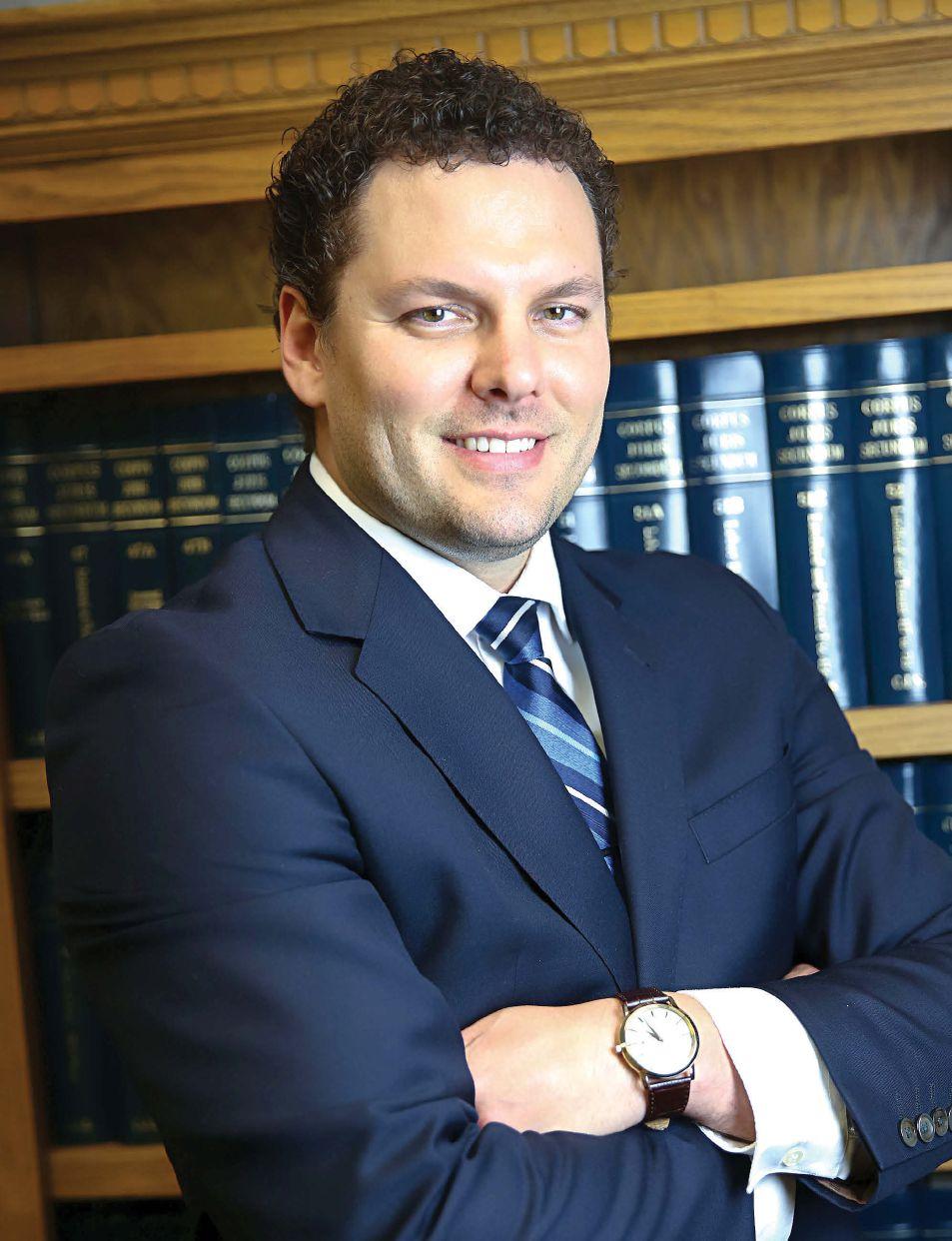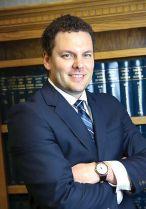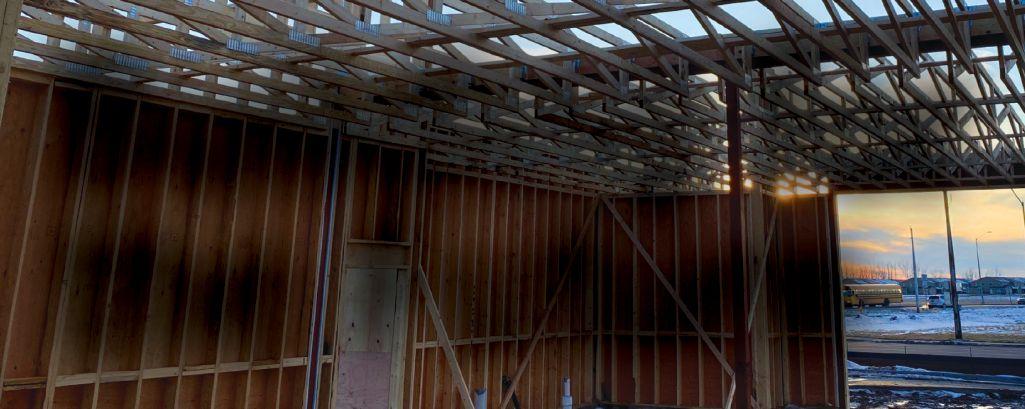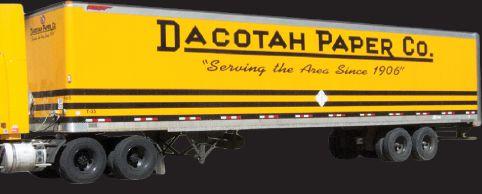Attorneys in Small Towns



PREMIER BUSINESS MAGAZINE OF THE NORTHERN PLAINS | JANUARY 2020

YourBusiness Isn’t CookieCutter. YourNetworkShouldn’tBeEither. That’s why Midco®Business listens to yourneedsfirst,andthencreates custom internetandnetworkingsolutions to help you succeed. We doitall for businesses bigorsmall.And we doit uniquely for you. That’s what itmeanswhen we say Midco Business works for you. Setup yourfree consultation at Midco.com/Consult, orcall1.800.888.1300 © 2019 Midcontinent Communications. All rights reserved


Buildsomethinggreat. Yo uw an ttoc on ti nu et ob uild as tu de nt -a th le te pr og ra mt ha tg iv es pla ye rs an d fa ns mo re th an ju st ah ome ic ea dv an ta ge —l ik eS t. Cl ou dS ta te Un iv ers it y, wh oh as pr oduced 35 NHL er s, 1H obe yB ak er winne r, an dd eca de so fl oy al fa ns .Todos o, yo un eed pa ssion at el ea de rs hi p, bi gg oals ,a nd JLGA rc hi te ct s. Se eh ow th eH us ki es ar ec hang in gt hegame at jl ga rc hi te cts .c om /S CS UN HC . ENRMount ainS tatesDesign Firmof theYear MSNMoney’s 50 Most AdmiredCompaniesinthe U.S. Inc. Magazine’s Best Places to Work |100%Employee- Owned ESOP




























// Your Security Enables Your Success. 800.7 23 .5 353 | ne tc ente r. net | Re ac ho ut to an ITexpe rt atNe twor kC en te r, In c. We canprotect youwithproactive, state-of-the -art cybersecurit yser vice. Secureyournetwork withmultiplelayersof intensivesecuritysolutions Getreal-time protection, includingmalware protectionandemail/web filtering Plan forthe future with ateamofcybersecurity expertsfocusedon mitigatingrisk


5 Evolved. Whenyoupickup ag lassofwater, youdon’tusuallythinkaboutwhereit comesfrom.That’showitshouldbe. Smar tm an agementof ap reciousresource. It’ssecondnatureatKLJ. KLJENG.COM
JANUARY

ON THE COVER:
JOSHUA WOLFE IS A GENERAL PRACTICE ATTORNEY WITH THE FIRM OLSON & BURNS IN MINOT, N.D., BUT ONCE A WEEK TRAVELS TO THE MUCH SMALLER TOWN OF KENMARE, ABOUT 60 MILES AWAY, TO SERVE CLIENTS IN THE RURAL NORTH DAKOTA COMMUNITY. EFFORTS LIKE THIS IS ONE WAY THAT LAW FIRMS ARE REACHING OUT TO THE SMALLER POPULATIONS WHERE TOWN-BASED LEGAL COUNSEL IS LACKING.

IMAGE: PHOTO COURTESY OF CATHIE LEIGH OF CATHIE LEIGH PHOTOGRAPHY
CHIEF FINANCIAL OFFICER. THE COMPANY SAID DONOVAN HAS NEARLY 20 YEARS OF EXPERIENCE LEVERAGING RESEARCH AND ANALYZING CURRENT HEALTHCARE TRENDS TO IMPLEMENT PROACTIVE STRATEGIES THROUGH EFFECTIVE FINANCIAL STEWARDSHIP, COMMUNICATION AND COLLABORATIVE LEADERSHIP. SHE WILL WORK CLOSELY WITH OPERATIONAL AND CLINICAL LEADERS IN THE ALIGNMENT OF STRATEGIC DIRECTION, MISSION AND VALUES.
6 TWITTER.COM/PRAIRIEBIZ FACEBOOK.COM/PRAIRIEBUSINESS PRAIRIEBUSINESSMAGAZINE.COM TABLEOFcontents FEATURES DEPARTMENTS 8 Editor’S NOTE CHANGE: THE LAW OF LIFE AND BUSINESS BUSINESS INSIDER 20 ‘LOVE YOUR PEOPLE’ A Q&A WITH INCOMING UNIVERSITY OF NORTH DAKOTA PRESIDENT ANDREW ARMACOST Safety Conference 24 MAKE SAFETY A PRIORITY WITHIN YOUR BUSINESS 26 PRAIRIE PEOPLE 28 INSIGHTS & INTUITION RURAL ATTORNEYS HOW LAWYERS AND LAW FIRMS ARE HELPING TO GET ATTORNEYS INTO RURAL COMMUNITIES. 10 Law COAL INDUSTRY A LOOK AT THE LIGNITE COAL INDUSTRY AND WHAT IT MIGHT LOOK LIKE IN THE FUTURE. 14 Energy INTERNATIONAL STUDENTS WHAT COLLEGES AND UNIVERSITIES ARE DOING TO ATTRACT MORE INTERNATIONAL STUDENTS. 18 Higher ed prairie people VISIT WWW.PRAIRIEBUSINESSMAGAZINE.COM TO SEE THESE AND OTHER NEW HIRES, PROMOTIONS AND AWARD WINNERS IN THE REGION. TERRI DONOVAN JOINS CHI ST. ALEXIUS HEALTH BISMARCK, N.D. – TERRI DONOVAN HAS JOINED CHI ST. ALEXIUS HEALTH AS THE VICE PRESIDENT OF OPERATIONAL FINANCE AND
A STUDENT POSES FOR A PHOTO AFTER SHE WON BEST DISPLAY DURING A CONTEST IN 2018 AT MINOT STATE UNIVERSITY. EXPANDING CULTURE AND ECONOMY, PAGE 18.
IMAGE: COURTESY OF MINOT STATE UNIVERSITY
30 BY THE NUMBERS 2020 VOL 21 ISSUE 1
WHO WILL MAKE THE LIST IN 2020?
Prairie Business Magazine is accepting nominations for our annual Top 25 Women in Business. We’re seeking those women who are making big moves and leading the way in their careers and communities.


If you know a great candidate for this coveted list, go to prairiebusinessmagazine.com and click on the Top 25 Women in Business logo to submit a nomination.
Nominations accepted through January 13, 2020.

7
The Law of Life and Business Change:
Iread once that there is not much growth in our comfort zones, and not much comfort in our growth zones.
Change – whether that’s relocating to a new area, starting a new job, or trying a new business model, among a number of other periodic changes – is not always easy. In fact, sometimes it’s downright tough. Lucky for us there was Socrates.
“The secret of change,” he said, “is to focus all your energy not on fighting the old but on building the new.”
Wise words from someone who has been called the father of Western philosophy.
I’m still trying to “build the new” as I adjust to changes in my own life and career – settling into a new area, learning my new job and responsibilities, and being away from family and friends who are back in the West. I’m also adjusting to the climate of the upper Midwest.
But all is well, and I am making concerted efforts to apply Socrates’s philosophy. Along the way I am experiencing new adventures, learning new things, and getting to know the good people in the Dakotas and western Minnesota, including my new work family at Prairie Business and its sister publication the Grand Forks Herald. Great people, all, and I am proud to call them colleagues and friends.
But life and business are about change, and as you read this issue of Prairie Business, you’ll notice change is a big part of the feature stories presented here.
What are the ways that law firms and rural communities are adapting with regards to getting more attorneys into rural communities where town-based legal counsel might not be available? You’ll find out in our story about lawyering in small towns.
For our energy topic this month, Sam Easter looks at the lignite coal industry and the changes that industry is confronted with and likely will be for some time to come.
Also, find out what changes are happening on the higher education scene, especially what one South Dakota university is doing to attract more international students.
It’s a changing world, and there are trends all around us. Sometimes change is uncomfortable, as I mentioned, but other times it’s a boon. January is a good time to reflect upon the changes in our lives and businesses, what changes might be beneficial for us to make ourselves, and then to put a plan in motion to make those positive changes happen.
“If you do not change direction,” said Lao Tzu, the ancient Chinese philosopher, “you may end up where you are heading.”
And one more, this one from President John F. Kennedy: “Change is the law of life. And those who look only to the past or present are certain to miss the future.”
Until next time, Andrew Weeks
I look forward to hearing from you at aweeks@prairiebusinessmagazine.com or 701-780-1276.
PUBLISHER KORRIE WENZEL
AD DIRECTOR
STACI LORD
EDITOR
ANDREW WEEKS
CIRCULATION MANAGER BETH BOHLMAN
LAYOUT DESIGN SARA SLABY
ACCOUNT MANAGERS
NICHOLE ERTMAN 800.477.6572 ext. 1162 nertman@prairiebusinessmagazine.com
PETER FETSCH 800-477-6572 ext. 1172 pfetsch@prairiebusinessmagazine.com
Prairie Business magazine is published monthly by the Grand Forks Herald and Forum Communications Company with offices at 375 2nd Avenue North, Grand Forks, ND 58203. Subscriptions are available free of charge. Back issue quantities are limited and subject to availability ($2/copy prepaid). The opinions of writers featured in Prairie Business are their own. Unsolicited manuscripts, photographs, artwork are encouraged but will not be returned without a self-addressed, stamped envelope.
SUBSCRIPTIONS
Subscriptions are free www.prairiebusinessmagazine.com
ADDRESS CORRECTIONS
Prairie Business magazine Box 6008 Grand Forks, ND 58206-6008
Beth Bohlman: bbohlman@prairiebusinessmagazine.com
ONLINE www.prairiebusinessmagazine.com

8 TWITTER.COM/PRAIRIEBIZ FACEBOOK.COM/PRAIRIEBUSINESS PRAIRIEBUSINESSMAGAZINE.COM Editor’snote
Andrew Weeks
Editor
JANUARY 2020 VOL 21 ISSUE 1
Buildingfor theFuture

the Futu r

ThroughouttheMidwest
LloydCompaniesisexpandingbusinessin2020with anew divisionandnewlocationsthroughouttheMidwest.
LloydCompaniesisexpandingbusinessin2020with anew divisionandnewlocationsthroughouttheMidwest.

LloydHospitalityGrouplaunchedin2019andisofftoafast startdeveloping,buildingandmanaginghotelsin amulti-state area. We’realsoextendingthemissiontobuildupcommunities withhotels,multifamilyhousingand retailinnewlocations includingRapidCity,CedarRapids,KansasCityandmore.
LloydHospitalityGrouplaunchedin2019andisofftoafast startdeveloping,buildingandmanaginghotelsin amulti-state area. We’realsoextendingthemissiontobuildupcommunities withhotels,multifamilyhousingand retailinnewlocations includingRapidCity,CedarRapids,KansasCityandmore.

Visit LloydCompanies.com tolearnmore.
Visit LloydCompanies.com tolearnmore.
SIOUX STEEL
Opening 2022
SIOUX STEEL
The first phase of this mixed-use development in Downtown Sioux Falls will include aCanopy by Hilton, a nine-story mixed-use building and a parking ramp wrapped with apartments, office and retail space.
Opening 2022
The first phase of this mixed-use development in Downtown Sioux Falls will include aCanopy by Hilton, a nine-story mixed-use building and a parking ramp wrapped with apartments, office and retail space.

DOWNTOWN RAPID CITY DEVELOPMENT
Opening 2022
DOWNTOWN RAPID CITY DEVELOPMENT
This redevelopment will turnaparking lot in downtown Rapid City into amixed-use project consisting of apartments, ahotel, meeting space, retail, surface and underground parking space.
Opening 2022
This redevelopment will turnaparking lot in downtown Rapid City into amixed-use project consisting of apartments, ahotel, meeting space, retail, surface and underground parking space.
DEVELOPMENT REAL ESTATECONSTRUCTIONPROPERTYMANAGEMENTHOSPITALITY APARTMENTS
DEVELOPMENT REAL ESTATECONSTRUCTIONPROPERTYMANAGEMENTHOSPITALITY APARTMENTS
Attorneys in Small Towns
How big city firms are doing small-town lawyering in the Prairieland
By Andrew Weeks | Prairie Business Editor
When Joshua Wolfe was a teenager living on his family’s farm in a rural North Dakota community, he picked up a book that pointed him to his career.

By the time he finished reading “To Kill a Mockingbird,” the modern classic by Harper Lee, he knew he wanted to become a lawyer. Not just any lawyer, however, but one who exemplified the values of the book’s protagonist, Atticus Finch.
“I learned from reading that book that there are lawyers with moral character,” Wolfe said.
Wolfe knew that even though Finch was a fictional character, he could take lessons from the book and apply them to his own life and career. He said lawyers often get a bad rap as being sleazy, money-hungry fakes, but he wanted to honor the profession by being a hard worker with a deep concern for his clients and the justice system.
There was something else about the book that resonated with Wolfe: lawyering in a small town.
TWITTER.COM/PRAIRIEBIZ FACEBOOK.COM/PRAIRIEBUSINESS PRAIRIEBUSINESSMAGAZINE.COM 10 Law JANUARY 2020 VOL 21 ISSUE 1
***
ATTORNEY JOSHUA WOLFE WANTED TO BECOME A LAWYER EVER SINCE HE READ HARPER LEE’S CLASSIC NOVEL, ‘TO KILL A MOCKINGBIRD.’ IMAGE: COURTESY OF JOSHUA WOLFE
Lee sets her novel in the “tired old town” of Maycomb, Ala. Wolfe works as an associate attorney in general practice with the firm Olson & Burns based in Minot, N.D., but once a week makes the roughly 60-mile trip to the much smaller town of Kenmare. It is in this town, which has a population of a little more than 1,000 people by the latest census estimates, where out of the community room of a local bank he works with residents seeking legal advice in the rural community.
His being there once a week is a way for people to access an attorney with-

take a
Civil & Municipal Engineering & Planning

Water & Wastewater Engineering
Transportation Planning & Engineering
Bridge & Structural Services
Aviation Services
Water Resources Engineering
Planning & Urban Design
Land Surveying
Geographic Information System
Project Funding & Financing
Bolton-Menk.com
11
Real People
Real Solutions.
We
personal interest in the work being done around us. And at the end of the day, we’re
offering
out having to drive long distances themselves, one of the challenges many rural communities are faced with if they don’t have town-based legal counsel.
Wolfe is one example of how law firms and lawyers are trying to combat the shortage of attorneys in small-town America. While challenges still exist on this front, the outlook is trending more positively, especially with partner programs between law firms, universities and other organizations.
Wolfe, a graduate of the University of North Dakota School of Law, was part of a pilot program that started in 2014 to get law students to intern with judges in rural areas. The program was a collaborative effort between the university, the North Dakota Supreme Court and the State Bar Association of North Dakota, but the following year it expanded with a grant from the Edson & Margaret Larson Foundation.
Wolfe clerked for Judge John C. McClintock Jr., chambered in Rugby, N.D., where he became familiar with both the challenges and rewards of working in a small community. That familiarity expanded when he started working for Olson & Burns a year later and was put in charge of operating its satellite office in Kenmare. He said if young attorneys want to make their mark and their money, practicing in small towns isn’t a bad option.
The challenge is that for years there hasn’t been enough attorneys who want to work in the smaller communities.
That doesn’t mean that the legal profession is declining. On the contrary, according to a 10-year survey by the American Bar Association, the number of attorneys nationwide increased by 14.5% since 2009. Of Prairie Business magazine’s three-state coverage area – North Dakota, South Dakota and western Minnesota – only North Dakota saw a slight decline (0.4%) in the number of attorneys from 2018 to 2019. Also, the number of lawyers overall is projected to grow by 6% over the decade – or about as fast as the average for most occupations – according to the Bureau of Labor Statistics.
“Competition for jobs over the next 10 years is expected to be strong because more students graduate from law school each year than there are jobs available,” the report reads.
The number of students attending law school might once have been declining, but now numbers are trending the other way. The University of North Dakota School of Law, for instance, saw a 33% increase in the number of law students during the 2018-19 school year, according to the law school’s dean, Michael McGinniss.
“We're excited about that,” he said. “I think there's, you know, some years back there was a decline in students applying to law schools around the country. The data is indicating that those applications have now been rising the past year.”
But the positive numbers mask the real-life problems that rural communities are faced with regarding the legal services business. Wolfe said he’s seen the problem firsthand and understands that attorneys, like anyone else in other fields, have to go where the money is, and a lot of young attorneys believe that’s in the bigger cities. That often means when a lawyer in a small community leaves the practice, there isn’t anyone else to continue the services.
“There’s a real vacuum taking place in rural communities,” he said. “You have attorneys in the small towns that are in their early to mid60s, getting ready to retire, and there's just not a young lawyer willing
to come into these small communities and set up shop.”
Patrick Goetzinger, an attorney with Gunderson, Palmer, Nelson, Ashmore in Rapid City, S.D., and who serves on the American Bar Association Board of Governors, saw the same problem in his home state and at one time painted the picture with darker colors. Attorneys in rural communities, he said, including South Dakota, are a dying breed. ***
Or at least they were at one time, but now another scenario is trending. The outlook is slowly but surely improving, at least in some parts of the region. “I don’t think they are a dying breed anymore,” Goetzinger said. “Attorneys are now alive and well in South Dakota.” Goetzinger founded Project Rural Practice in South Dakota, whose task force in turn prompted the state’s chief justice to come up with the Rural Attorney Recruitment program; basically, a measure for the Legislature to “throw money at the issue by creating a pool of dollars that would provide an incentive payment to lawyers that would relocate or establish a practice in qualifying rural communities,” he said. “As a result of appropriation that we received from the state of South Dakota, and the matching funds that came from the local community and our State Bar Foundation, we were able to pull $1 million that we could then use to provide an incentive payment for each year of a five-year period for the lawyers.”
The program started by placing 16 law students – dubbed the “Sweet Sixteen” – in 16 qualifying communities.
Goetzinger said he saw the writing on the wall for rural practices at least 20 years ago, when a lawyer in his hometown of Martin, S.D., left the only law firm in town. In doing so, it left the community without home-based legal counsel and no prospective attorneys to fill the void.
“We saw that happening from town to town, landscape to landscape, main street to main street, across the state where there were lawyers retiring from towns with no lawyers to take over and no prospects for successors,” he said.
When Project Rural Practice started in 2013 it aimed to get attorneys into counties with a population of fewer than 10,000 residents. Goetzinger said that 45 of South Dakota’s 66 counties qualified under that criteria, but new criteria has since been passed and much smaller populated towns within those counties have been served. Of the 32 permanent positions now available for funding, 24 are currently filled.
The University of North Dakota’s Rural Justice Program also has seen successes over the past few years, according to the law school’s dean, McGinniss.
He said the hope is that young attorneys in the program would get to know the community, residents would get to know them, and after graduating from law school the attorneys would settle into those same communities and start practicing law.
“The benefits are starting to be reaped from this initiative,” McGinniss said, noting the school has placed students from the program at several North Dakota locations such as Cavalier, Mayville and Spirit Lake Tribe, among others.
McGinniss said the university has plans to continue these efforts
TWITTER.COM/PRAIRIEBIZ FACEBOOK.COM/PRAIRIEBUSINESS PRAIRIEBUSINESSMAGAZINE.COM 12 Law JANUARY 2020 VOL 21 ISSUE 1
for the foreseeable future and applied for another grant through the Larson Foundation for the current school year.
Much like Lee’s protagonist in “To Kill a Mockingbird,” Wolfe believes everyone is entitled to have their legal rights protected, no matter where they live, in a big city or small town. That is the crux and bonum why it is important to get legal counsel into rural communities.
“Everybody is entitled to have their legal rights protected,” he said, “whether it's in a criminal setting, a family lawsuit or even in commercial litigation.”
There also are financial and other dividends that come from working in a rural practice. If an attorney is looking to get into the courtroom, a small town might be the place to do it. Also, as the larger industry is faced with fears of automation and artificial intelligence, something Prairie Business reported on in January 2019, a rural community law practice might be getting back to the very roots of the legal profession. There also usually is no dearth of work for the ambitious lawyer; the same cases that arise in big cities also happen in small towns.

Wolfe said legal work in rural communities is not just about tackling agriculture issues, as some might think. There’s that, of course, such as farm succession planning, but there’s also business succession planning, adoptions, criminal cases, divorces, estate planning, land sales, et al., basically all the things you’d see in a metropolitan area.
“The same legal issues that you see in Kenmare, you’d see in Fargo,” he said. “You still get the interesting cases in the small towns. ... And you know, the same crimes are being committed, just maybe not as often, but you're still seeing the same legal issues in the small towns as you see in the bigger cities.”
Just like in “To Kill a Mockingbird.”
Wolfe enjoys tackling the legal issues of rural America during his weekly visits to Kenmare. It is here, while sitting with a client in the bank’s community room, where he feels most attuned to his book hero Atticus Finch. His being there once a week has been a boon – for him, his clients, and the firm. He believes small communities in the upper Midwest are ripe for ambitious, young attorneys – or even senior ones – wishing to make their mark and their money.
“There’s definitely an opportunity out there in the smaller communities where an attorney, hanging his or her own shingle, can make a very livable career,” he said.
13 ANDREW WEEKS PRAIRIE BUSINESS EDITOR AWEEKS@PRAIRIEBUSINESSMAGAZINE.COM | 701-780-1276
***
THE MILTON R. YOUNG STATION, A COAL-FIRED PLANT NEAR CENTER, N.D., IS OPERATED BY MINNKOTA POWER COOPERATIVE. MINNKOTA HOPES TO FIT IT WITH A $1 BILLION CARBON CAPTURE APPARATUS DURING THE 2020S, MAKING IT THE LARGEST ‘POST-COMBUSTION’ CAPTURE IN THE WORLD BY CAPTURING 90 % OR MORE OF THE STATION’S EMISSIONS — EQUAL TO ABOUT 600,000 CARS. IMAGE: COURTESY OF MINNKOTA POWER COOPERATIVE

TWITTER.COM/PRAIRIEBIZ FACEBOOK.COM/PRAIRIEBUSINESS PRAIRIEBUSINESSMAGAZINE.COM 14
JANUARY 2020 VOL 21 ISSUE 1
ENERGY
The Upper Midwest’s Resilient Coal Industry
By Sam Easter
Leon Weisenburger plans to retire a coal miner.
He’s bounced around the country, working in coal in the 1990s before taking a high-ranking city job in Garrison, N.D., and following his wife, a nurse practitioner, to California. Now he works heavy machinery at the Coteau Freedom Mine, where he plans to stay for another 15 years. That’s about an hour’s drive from Underwood, N.D., where Weisenburger is the city’s commission president — functionally, the mayor.
Speaking by phone just hours before a 12-hour, overnight shift, he described a city where the economy is entirely dependent on coal. Underwood, Weisenburger estimates, has somewhere between 30% and 40% of its residents either working for a coal mine or a nearby coal-fired power plant. The town exists because of coal, and corporate coal dollars take good care of it, Weisenburger said, standing ready to help with the city’s daily life. The city’s website points out that the local golf course is “the result of a unique joint effort” between the city and a nearby mining company.
“When they talk about ‘go green,’ and this and that, it is concerning to coal miners,” Weisenburger said. “But what they don’t understand is that fossil fuels — that’s what built this country, fossil fuels did, and they’re forgetting that it can’t go away. It’s just a fact of nature that it will always be around, because it can be around with the flick of a switch, where wind-generated (energy) cannot, and neither can solar.”
Although the coal industry is slipping in many parts of the country — and renewable energy advocates are hard at work making wind and solar just as dependable as coal — the upper Midwest’s coal industry has been resilient. Federal data shows that the coal mining industry employed more than 175,000 nationwide in the mid-1980s, which has since fallen to about 53,000 as of October, the result of pressures from not just renewable energies and regulations, but inexpensive natural gas and automation as well.
But in places like North Dakota, the coal model is propped up by a relatively unique economic arrangement: lignite coal is mined
immediately adjacent to coal-burning plants, which then produce electricity for consumption within state borders and beyond. Widely referred to as a “mine-mouth” arrangement, it’s a way to drastically cut costs in coal power production.
“If it weren’t for the fact that we were exporting electricity, we probably wouldn’t have a coal industry, because lignite (coal) in and of itself is not competitive if it has to be transported large distances,” said Dean Bangsund, a research scientist and economist at North Dakota State University. Not only is the water content higher and the energy content lower, but the transport itself can increase prices. And there’s plenty of coal to last. Jason Bohrer is president and CEO of the Lignite Energy Council, a Bismarck-based group that advocates on behalf of the coal industry. He said that North Dakota currently has an 800-year supply of “economically recoverable” coal for the state’s current coal-fired plants.
The question, then, is about what the future will bring. There are other power sources gaining ground in the marketplace, like inexpensive natural gas and a growing renewable energy market. Ben Fladhammer, a spokesman for Minnkota Power Cooperative, said the company’s current power source portfolio is about 60 percent coal, down from 80% to 90% coal in the late 2000s, which comes on the heels of “tremendous” wind development in the upper Midwest. But a looming question for the coal industry is regulation. Coal has, historically, been a significant, if recently declining, source of carbon emissions in the U.S., with 1.1 gigatons in national projected emissions for 2019, according to the Global Carbon Project. Those emissions are increasingly at odds with movements to stem the projected effects of man-made climate change.
That tension stole the political spotlight during President Barack Obama’s administration, when the Clean Power Plan — a sweeping set of regulations meant to clamp down on emissions — called for steep reductions in carbon emissions around the country. In North Dakota, cuts to emissions would have been particularly steep, and Attorney General Wayne Stenehjem sued Obama’s Environmental
continued on page 17
15
North Dakota's coal industry appears healthy for now, but what is its future?

TWITTER.COM/PRAIRIEBIZ FACEBOOK.COM/PRAIRIEBUSINESS PRAIRIEBUSINESSMAGAZINE.COM 16 ENERGY JANUARY 2020 VOL 21 ISSUE 1
continued From page 15
Protection Agency in 2015, making North Dakota one of many states to take issue with the plan, which was repealed in 2017 under President Donald Trump.
“The thing that is going to put the biggest pressure on the coal industry going forward is issues that deal with carbon (emissions),” Bangsund said. “There is a considerable effort underway right now to look at CO2 capture as a means of making lignite-sourced electricity viable in a carbon-constrained economy.”
A lot of that work happens at places like the Energy and Environmental Research Center at the University of North Dakota. The group bills itself as a global leader on cleaner energy, working specifically on the kinds of carbon-capture technology that can prolong coal power’s viability under tighter regulations.

“In terms of timing, when these regulations come out…we simply don’t know,” said Josh Stanislowski, the EERC’s director of energy systems development. “A lot of it can be tied up in legal challenges, but a lot of it is tied up in politics, and the (2020 election) is going to play a big role in that.”
One of the most ambitious attempts to get ahead of the carbon capture curve is unfolding in North Dakota, where Minnkota is pursuing “Project Tundra” — a $1 billion carbon-capturing upgrade to the Milton R. Young Station, a giant coal-fired plant near Center, N.D. Dan Laudal, environmental manager with Minnkota, said that the project is in an advanced planning stage, seeking out investors with an eye to launch construction by 2022 or 2023. If completed, Laudal said, it would be the largest “post-combustion” carbon capture facility in the world.
“It’s certainly not at a point where we can call it a certainty, but I would say it’s transitioned out of the research domain,” Laudal said. “The most unknown piece of all of this is whether or not we can bring in financing.”
And for now, the North Dakota coal industry appears healthy. According to a January report co-authored by Bangsund, the North Dakota lignite industry was growing its compensation through at least 2017 though with employment “edging down” in those years, as Bangsrud described it. It’s the most recent data on the local industry Bangsund has at his disposal.
“So we have some mixed messages in terms of the economic footprint of the industry,” he said.
That’s an important issue not just for the industry, but for the cities and towns that depend upon it.
“The majority of the people that live in these smaller communities work at the coal mines, and the coal mining industry has very good wages and benefits,” Weisenburger said. “If it wasn’t for the coal mines, these towns would not exist.”
17
THE INTERIOR OF THE ENERGY AND ENVIRONMENTAL RESEARCH CENTER AT THE UNIVERSITY OF NORTH DAKOTA DURING AN EARLY 2017 TOUR. PICTURED IS THE CENTER’S APPARATUSES FOR TESTING CARBON CAPTURE METHODS. IMAGE: KARI SUEDEL, EERC
DAKOTA WESLEYAN UNIVERSITY, BASED IN MITCHELL, S.D., HAS OPENED AN INTERNATIONAL RECRUITING OFFICE IN AFRICA. IT IS ONE WAY THE SCHOOL IS SEEKING TO ATTRACT MORE INTERNATIONAL STUDENTS.
IMAGE: COURTESY OF DAKOTA WESLEYAN UNIVERSITY
Expanding Culture and Economy
By Andrew Weeks | Prairie Business Editor
A South Dakota-based university is expanding its footprint with its first international recruitment office in Africa, and by so doing hopes not only to enhance the cultural diversity of the campus and increase student population, but to strengthen the workforce of the upper Midwest and the region’s economy.
Dakota Wesleyan University in Mitchell, S.D., through a partnership with university alum and former board of trustee member Dr. John Ifediora, opened a recruitment office on Nov. 5 in Abuja, Nigeria.

“Dr. Ifediora has provided invaluable connections to the Nigerian private high schools, government schools and offices as we look to expand our international recruitment efforts for the fall of 2020,” DWU President Amy Novak said in a statement.
Ifediora, a professor emeritus at the University of Wisconsin System and currently on the faculty of economics at American University in Washington, D.C., is receiving help from two other university staff members, Godwin Kingsley and Honey-Ann Ndubuisi.
“In our exploration of the project, Dr. Ifediora said that parents of prospective students would like the idea of a rural location and would be looking for a place where their students can study in a safe and distraction-free place. Isn’t that interesting that he referred to this area as distraction-free?” Fredel Thomas, DWU vice president of admissions and marketing, told Prairie Business. “It is my understanding that some of the distraction he is referring to has to do with the activity of Boko Haram in Nigeria.” (Boko Haram is a militant
Islamic group, whose name, interestingly, means “Western education is forbidden,” according to a report by CNN.)
She said Nigeria is not the only location the school will expand its footprint. It also is looking to open another recruitment office in Nairobi, Kenya.
“I think many universities are searching for pipelines of students that will enhance the cultural diversity of their campuses as well as grow their traditional student population,” Thomas said, noting, however, that “opening a recruitment office isn’t something easy to do without the right connections and people to make it happen.”
What the numbers say
While not every college or university has recruitment offices in other countries – most do not – the schools in the upper Midwest that Prairie Business reached out to say they make concerted efforts to attract students from foreign lands. The economic impact seems to tell one reason.
Overall in the U.S., the number of international students reached an all-time high during the 2018-19 academic year, according to the Institute of International Education. Its 2019 Open Doors Report on International Student Exchange, released in November, said the total number of international students was 1,095,299, a 0.05% increase over the previous year. Further, international students make up 5.5% of the total U.S. higher education population. And according to data
TWITTER.COM/PRAIRIEBIZ FACEBOOK.COM/PRAIRIEBUSINESS PRAIRIEBUSINESSMAGAZINE.COM 18 HigherEd JANUARY 2020 VOL 21 ISSUE 1
Colleges and universities are trying to attract more international students, hoping not only to grow their own student body but the culture and economy of the upper Midwest
from the U.S. Department of Commerce, international students contributed $44.7 billion to the U.S. economy in 2018, an increase of 5.5% from the previous year.
Breaking the numbers down to Prairie Business’s three-state coverage area, it looks like this:
• The estimated international student expenditure during 20182019 academic year in North Dakota was $53,445,006. Most of the state’s international students came from Canada (16.5%), but China (15.7%), India (9.5%), South Korea (6.2%) and Japan (5%) also were represented.
• Estimated expenditures of international students in South Dakota was $45,375,976, with most of the international student population in the state being from India (15.6%).
• Monetary contributions in Minnesota was $482,542,587. Most of the international student population here came from China (28.6%).
Besides expanding its own footprint and enticing more students to the campus in Mitchell, Thomas said, the effort by Dakota Wesleyan University to enroll more international students has a larger dividend for the region’s economy.
“We can tell a number of stories about international students completing their studies at DWU and staying in the community or region,” she said. “As a perfect example, we currently employ an international graduate in our admissions office and are greatly benefiting from his cultural awareness as well as his ability to speak Spanish.
“As you can imagine, this is very helpful in recruiting both international and domestic students who speak Spanish and he adds a great dynamic to our team.”
Thomas believes many other industries in the region can benefit from these same efforts as they hire international students.
“That goes without mentioning just the increase in workforce,” she said. “These are students that are coming to Mitchell for an experience, gaining a great education and, if the university and the community can make that experience great, they just might stay and make it their home.”
That is at least a long-term goal of the more immediate efforts of recruiting additional international students.
To date, the university has welcomed students from many countries, including Argentina, Australia, Brazil, Canada, the Cayman Islands, Ecuador, England, Ghana, Ireland, Mexico, Panama, South Africa, Uganda and the United Kingdom.
Thomas said foreign students often are attracted to pursuing business and science degrees.
“We also think there may be a market for our masters in business administration and our graduate level nonprofit church leadership program,” she said.
What other schools are doing
Colleges and universities that do not have recruiting offices in foreign lands still find avenues to attract international students.
In the case of the University of Minnesota Crookston, the school uses a number of strategies to attract international students, according to the university’s John Hoffman, vice chancellor for academic and student affairs. He said one of the ways that has proven most successful is partnering with other institutions, in which, he explained, the school “developed memos of understanding and part-
nership agreements over the years,” including “working with several recruitment agencies in Asia.”
“We do not have recruitment offices, per se. We work with agencies that serve South Korea, Vietnam, and China. We have also had success in recruiting students from South Asia, Africa, and South America,” he said. “These focused strategies help us to build stronger relationships and familiarity with our partners, which helps to promote positive transitions and success for our international students.”
Hoffman said while many of the school’s students return to their homelands after graduation, many others choose to stay. But even those who decide to return home still contribute to the local economy while they are here and add to the cultural experience of the area.
“The larger value is more indirect, as the presence of international students on campus bolsters the internationalization of the curriculum for all students,” he said. “Thus, domestic students who stay in the region after they graduate have stronger global competencies, which helps them with global aspects of markets, business, etc.”
In Minot, N.D., 294 international students were enrolled in the fall 2019 semester at Minot State University, or nearly 3% of the school’s total student population of 3,000.
The school attracts international students through its “Grow North Dakota” tuition model, which allows all students to pay in-state rates, according to Libby Claerbout, the university’s director of International Programs.
“The one-rate tuition model helps Minot State stand out nationally and internationally as a welcoming place for all students,” she said. “In-state tuition helps us stay competitive.”
While the school does not have any recruitment offices in other locations, its enrollment services staff takes frequent trips to Canada to work with Canadian applicants and their parents.
At the University of North Dakota, based in Grand Forks, incoming president Dr. Andrew Armacost told Prairie Business that international students play a vital role at the school for a number of reasons, including economic ones, but also “to bring an international perspective to life on campus.”
The university does not have a specific international recruitment program, according to Debbie Storrs, senior vice provost of Academic Affairs, but said the university relies on its website to attract international students. If a student is looking for schools with a good aerospace program, for instance, he or she likely will find UND on the web. Storrs said besides international students coming to the campus, the university encourages domestic students to study abroad.
According to UND’s “Enrollment Profile – Demographics, Academics and Residency,” said university spokesman David Dodds, the school had 537 international students, or about 4% of its total 13,581 students, from the 2019 UND census headcount.
“Certainly there's an economic benefit if you have students who are coming in and paying tuition, whether it's full tuition or partial tuition,” Armacost said. “That, of course, helps the bottom line of the university.”
But there’s another real-life impact that is important to him. Armacost, who is slated to begin his new duties on June 1, said having a robust international program is important to his administration and plans to make it one of his priorities.
“The more we can pull in folks from across the globe, the more real the impact of globalization,” he said, “and all of our students will have an appreciation for what it means to be a citizen of the world and how the social and economic and political interplay happens between the United States and the rest of the world.”
19
ANDREW WEEKS PRAIRIE BUSINESS EDITOR AWEEKS@PRAIRIEBUSINESSMAGAZINE.COM | 701-780-1276
‘Love your people’
A Q&A with incoming University of North Dakota President Andrew Armacost

EDITOR’S NOTE:
After an extensive search for the next president of the University of North Dakota, the school found its match in Dr. Andrew Armacost.
On Dcec. 3, the State Board of Higher Education named Armacost UND’s 13th president. It’s a position the incoming president is excited about, and said he already feels a connection to both the campus community and the larger community of Grand Forks, where the school is located. He said he’s looking forward to working with other communities across the state and country in his new role as he seeks to propel the school forward despite challenges in higher ed.
He comes to UND after 20 years working at the U.S. Air Force Academy in Colorado, most recently as its dean of faculty.
Though he won’t officially start at the university until June 1, he said he plans to be on campus for spring alumni events and other activities.
Armacost recently spoke with Prairie Business about what he envisions in his new role, what he wants to achieve as president, and the ways he plans to work with the business community.
In short, he said being named UND’s next president is a gesture he doesn’t take lightly.
“What an honor this is,” he said. “It is an exciting time not only for me but also for my wife, Kathy. We look forward to taking the helm at the university and moving to Grand Forks.”
20 TWITTER.COM/PRAIRIEBIZ FACEBOOK.COM/PRAIRIEBUSINESS PRAIRIEBUSINESSMAGAZINE.COM BUSINESSINSIDER JANUARY 2020 VOL 21 ISSUE 1
DR. ANDREW ARMACOST HAS BEEN NAMED THE 13TH PRESIDENT OF THE UNIVERSITY OF NORTH DAKOTA. HE WILL BEGIN HIS NEW DUTIES ON JUNE 1, BUT SAID HE PLANS TO BE ON CAMPUS BEFORE THAT TO PARTICIPATE IN ALUMNI AND OTHER EVENTS. IMAGE: ERIC HYLDEN/GRAND FORKS HERALD
HOW HAS YOUR PREVIOUS




ESPECIALLY AS DEAN OF FACULTY AT THE U.S. AIR FORCE ACADEMY, PREPARED YOU FOR YOUR NEW POSITION AS UND PRESIDENT?

I feel it has prepared me on a number of levels. As the head of faculty and the chief academic officer at the Air Force Academy, both have prepared me for this new role. I’ve been a part of the senior leadership team that has run a national flagship academic institution that has a lot of things going on – from character and leader development to academics to athletics and flying programs. So, having my hands at the very senior levels of those types of decisions, I think, has prepared me well for leading UND. In addition, for an undergraduate school, the Air Force Academy is the No. 1 funded research program in the US. The amount of work we spent to create the research infrastructure, about $55 billion in funding each year that comes in to support our research programs, well, I had a great experience managing that kind of portfolio, research activities and also looking at how you transfer that technology to commercial applications when possible.
WHAT ARE YOUR SHORT-TERM PLANS FOR UND?
Well, the short-term plans for me personally are to get acclimated, to learn as much as I can about the inner workings of the university, to understand the aspects of its strategic plan … which aspects of that strategic plan are working well, and which areas we need to refine and define, either more completely or look at other areas that should be covered. So really, my first number of months will be just building relationships with members on campus and off campus and really trying to refine the direction of the strategic plan using campus inputs as a focal point.

subscribe To Our free Digital Edition Visit www.prairiebusinessmagazine.com or text: PBMAG to 72727 Like and follow us Fargo | Grand Forks | Bismarck | Minot | Fergus Falls S Copiers S Printers S Wide Format S Mailing Systems S Managed Print & IT Services S Document Management 21 Q. Q. A. A.
EXPERIENCE,
WHAT ARE YOUR GOALS TO HELP FOSTER A SENSE OF COMMUNITY AND BELONGING FOR STUDENTS AT THE UNIVERSITY?
Well, first and foremost is understanding where they are in terms of that sense of belonging and sense of purpose. The university has recently executed a climate survey to understand that better, and I think amplifying those efforts is important, to routinely solicit feedback from the entire campus community – faculty, staff, students – to understand where we can support their needs even better over time. So that’s one instrument that I think will be very useful. I think presence on campus – my presence, but also the presence of other senior academic and institutional leaders – needs to be at the forefront of how we operate. I think the entire student-body faculty and staff need to see all of us fully engaged in the happenings on campus and in the lives of all of its members.
YOU MENTIONED DURING ONE Q&A SESSION AT UND THAT GIVING ORDERS AND EXPECTING THEM TO BE OBEYED WAS A HOLLYWOOD MYTH, AND THAT YOU FOCUS MORE ON BUILDING CONSENSUS AND COLLABORATION. WOULD YOU EXPOUND ON THIS?
Right, so the Hollywood myth is that a general officer will walk in the room (and his or her wishes are automatically obeyed). There are times when that happens, but the majority of work is actually overseeing large organizations and working with the members of those organizations to make change and to execute the mission of the organization. Consequently, an extraordinary amount of work has to go into building teamwork and building trust. That’s the very essence of this idea of relationship building that allows that to happen, and I think a university, as a large and complex organization, relies on the same need to really build a sense of trust and purpose among its membership.
A.
WHAT ARE YOUR LONG-TERM PLANS FOR THE UNIVERSITY?
Well, I think there are a number of long-term challenges facing all of higher ed. I think stabilizing enrollment at UND is a priority, especially with the big projected dip in the high school class of 2025 – the post recession dip that happened back in 2007-2008; and enrollment management is going to be a big issue that we face. Secondly, how do we make steps toward becoming a very high-research activity university … and really parlay that research into something beneficial for the state of North Dakota and the nation. I think there are many areas there that we can continue to grow and perhaps even new areas of research that we can focus on. And then one of the most important components of UND is the tremendous sense of community: I want to make sure that we take all necessary steps to make sure we are unified in our support of each other, that the campus community is well constructed and cohesive, and that we can wrestle with the tough, tough issues that our society faces together and in a respectful way. I want to make sure that the campus community itself – this great collection of human beings – is tightly unified.
Q.
Q. A. A. A.
HOW DOES THIS TRANSLATE WITH RELATIONSHIPS OUTSIDE THE SCHOOL? WHAT WILL YOU DO TO STRENGTHEN THE SCHOOL’S RELATIONSHIP WITH THE BUSINESS COMMUNITY, BOTH LOCALLY AND IN THE STATE?
The fact is the University of North Dakota serves as an important economic engine for the state and also for the nation, and so working with local industry leaders and elected officials is an essential piece of running the university. We should look for every opportunity to have students and faculty members engaged in community goings-on; if there’s work that’s being done by students that could tie nicely to industries throughout North Dakota, I think we should identify those connections and try to make them happen. Those relationships, the external relationships, are a different type of relationship than what you build with your faculty, staff and students, yet the university will need to maintain these relationships in order to thrive.
TWITTER.COM/PRAIRIEBIZ FACEBOOK.COM/PRAIRIEBUSINESS PRAIRIEBUSINESSMAGAZINE.COM 22 BUSINESSINSIDER JANUARY 2020 VOL 21 ISSUE 1
Q. Q.
WHAT ARE YOUR PRIORITIES WITH THE PARTNERSHIP BETWEEN THE SCHOOL AND GRAND FORKS AIR FORCE BASE?
There are ample opportunities, particularly in the realm of advanced aerial systems, and I will look very closely at how we can continue to extend that partnership and look for additional ways to collaborate both with the Air Force and also with the industry partners that work out at Grand Sky, that great public-private partnership that exists at the Sky facility. I see that as a huge possibility for growing our work on autonomy and unmanned systems.
IF YOU WERE TO HAVE A MOTTO OF YOUR LEADERSHIP AT UND, SOMETHING YOU FOLLOW REGULARLY, WHAT WOULD IT BE?
My philosophy has been “love your people.” It’s very simple. It just means a commitment to the people who make your vision go – faculty, students and staff members – and to treat them with dignity and respect and to make sure that their needs are taken care of. That’s how universities become great, by attracting and retaining quality people.
IF FACED WITH BUDGET CUTS, WHAT WOULD YOUR PRIORITIES BE FOR THE SCHOOL?
It’s hard to pinpoint all of the competing priorities since I haven’t been lobbied yet by all the different constituencies on campus, but preserving a worldclass education for the students and preserving stability for the faculty are very important. They’re very high on my list. I know that cuts to the budget have led to challenges with respect to faculty and staff, yet those are the very fabric that our university depends upon – the faculty and staff – to deliver worldclass education. How we protect and preserve those elements that really deal with human beings, I think, is essential. And again, when it comes to prioritizing everything on the list, I’m still learning about what the full list entails, so it’s tough to pick and choose what might come off and what might stay on.
IN SUMMARY, WHAT IS YOUR BUSINESS MODEL FOR THE UNIVERSITY?
I want to have a local, interesting business model that generates revenue from multiple sources, whether it’s a student tuition, whether it’s from the state legislature, whether it’s from private philanthropy; and the way that you continue to attract that financial engine is by focusing on the relationships and the value of what it is that the University of North Dakota provides. Fortunately, that’s a sell that should be easy, simply because of the high-quality programs that we offer, the breadth of programs at both the undergraduate and graduate levels, and the opportunity for citizens of North Dakota … and nationally to come and be a part of something that’s truly remarkable. So the … ability to convince those multiple funding sources to keep this business alive – I think it’s a very strong case and I will, as the president, make sure that I’m the champion and ultimate cheerleader for the institution, to make sure that everybody recognizes the value that the University of North Dakota gives to the state of North Dakota and also to the nation.
23
Q. Q. Q. Q. A. A. A. A.
Make safety
a priority within your business
By Andrew Weeks | Prairie Business Editor

TWITTER.COM/PRAIRIEBIZ FACEBOOK.COM/PRAIRIEBUSINESS PRAIRIEBUSINESSMAGAZINE.COM 24 BusinessSafety JANUARY 2020 VOL 21 ISSUE 1
RONN LEHMANN SPEAKS ABOUT SAFETY DURING A BREAKOUT SESSION AT THE NORTHERN REGION ASSOCIATION OF SAFETY PROFESSIONALS CONFERENCE, DEC. 3 AT THE DELTA HOTEL IN FARGO. IMAGE: ANDREW WEEKS/PRAIRIE BUSINESS
People sat at tables, some of them with eye patches, artificial limbs, and scarred bodies — the victims of workplace accidents.

The takeaway: If safety isn’t the core value of your business, you might need to rethink your organization.
Accidents happen, of course, even when safety measures are followed — but the chances of such things happening are much less than when safety rules are ignored.
Just ask Ronn Lehmann. Though he has all of his limbs intact, he has met a number of people who have been permanently changed by workplace accidents.
Lehmann, a business consultant and motivational speaker, spoke to business professionals and employees during the Northern Region Association of Safety Professionals Conference. The two-day conference, held Dec. 3-4 at the Delta Hotel in Fargo, included participants from across the region.
In one breakout session during the first day of the conference, Lehmann emphasized how every person in an organization, whether senior manager or new employee, plays an integral part in workplace safety. But how much priority a person or organization places on safety stems from several influences and values, both within the workplace and without: culture, money and mindset, to name a few. Much of Lehmann’s focus was on “mindset” issues.
“To be successful at anything, you need the right mindset, skill set and tool set,” he said. “Of these, mindset is the biggest determinant of success or failure.”
Why? Because mindsets drive behaviors. “So,” he explained, “if you want to change behaviors you have to change mindsets.”
To emphasize his point, he shared six reasons people may not work safely:
1. Don’t know what to do
2. Don’t know how
3. Don’t have the tools
4. Don’t want to
5. Think they are working safely; and
6. Don’t think they have to
Training goes only so far because it only addresses the “how” issue. Of the other five, he said, four are mindset issues. But how do you change mindset?
One suggestion for business leaders is to consider the culture of their organization.

Culture can be effective promoting core values such as safety, but it also can, unintentionally, deemphasize safety if it is not one of the main values of the company.

Lehmann said culture is created by individuals and not organizations, and often is learned by what is rewarded and punished within a company. In a nutshell, he said, culture is comprised of its values and those of the individuals working there.
“What is the core value of your organization?” he asked, noting for some companies there might be dilemmas if safety isn’t its core value.
If an organization values both safety and productivity, for instance, what happens when they collide? “If productivity wins, it can lead to cutting corners on safety and taking risks,” he said. “If safety wins, it can lead to schedule delays and budget problems.”
A lot of intricate things are at play, but in the end following safety rules isn’t rocket science. It may take time, but the good thing is that culture can be amended and, in turn, so can mindsets. Lehmann offered business leaders and employees some suggestions with the aim of bringing more safety to the workplace:

Check your values. What’s important to you? If safety is a core value for you at home, it should also be a core value to you in the workplace. Be an example. Everyone, including you, are in a position to influence safety in the workplace by conduct, example, and encouraging others. If you see someone who is not being safe, speak up or report it to your supervisor.
Communicate, communicate, communicate. Communication starts at the top down, but everyone in a business setting should openly communicate with each other about safety procedures. Everyone should know what is expected of them.
Company leaders need to set the example. They need to talk openly and frequently about safety in the workplace or on the job site, and they need to follow up to make sure safety rules are continually being followed. Managers need to set the example for their employees by following those same rules and staying true to the company’s safety standards in all situations and at all times, he said.
25 PROUDMEMBERS OFOURCOMMUNITY
ENERGY &ENVIRONMENTAL RESE ARCH CENTER Ourmultidisciplinary team of over 200provides practical,pioneeringsolutionstothe world’s energyandenvironmental challenges
www.undeerc.org
PRO QUARTERBACK CARSON WENTZ PARTNERS WITH BOBCAT COMPANY
WEST FARGO, N.D. – Carson Wentz, a star quarterback at North Dakota State University, and Bobcat Company, a global leader in the compact equipment industry, have partnered in marketing efforts.

“We are excited to have such an accomplished and principled athlete, who shares a deep connection to North Dakota representing our brand,” said Mike Ballweber, president of Doosan Bobcat North America. “Carson demonstrates perseverance, grit and a tireless work ethic both on and off the field, which truly embodies Bobcat’s standards of performance and toughness.”
Raised in Bismarck, N.D., Wentz developed into one of the most successful athletes in the state’s history. A star quarterback at North Dakota State University, he was a part of five national championship teams. Wentz has experienced considerable professional success since being a top pick in the 2016 draft.
Wentz will be featured prominently within marketing efforts for Bobcat, including advertising, dealership signage and the company’s digital and social media platforms. He also will make appearances on behalf of the company.
BLUE CROSS BLUE SHIELD OF NORTH DAKOTA HIRES NEW CHIEF MEDICAL OFFICER
FARGO, N.D. – Blue Cross Blue Shield of North Dakota has welcomed Dr. Greg Glasner as its chief medical officer.

In his new role, Glasner has overall responsibility and accountability for leading the strategic direction of clinical integration, medical policy and health cost management.
Trained as an OB/GYN physician, Glasner has more than 25 years of experience as a practicing physician and healthcare executive. He previously served as a board member at BCBSND for nine years and is well acquainted with the organization.
Among his many accomplishments, Glasner earned his medical degree from the University of North Dakota, Grand Forks. He completed residencies at St. Paul Ramsey Medical Center and Michigan State University/ Sparrow Hospital and is also board certified by the American College of Obstetrics and Gynecology.
He is a Fellow of the American College of Obstetrics & Gynecology, and a member of the North Dakota OB/ GYN Society, North Dakota State Medical Association and First District Medical Society.
RED RIVER DANCE NAMES NEW EXECUTIVE DIRECTOR
FARGO, N.D. – Caitlin Killoran has been hired as the new executive director of Red River Dance & Performing Co. Killoran holds bachelor degrees in management and health communication from North Dakota State University, and brings extensive management experience as a business owner to the organization. Her role will include oversight of the company’s recreation, outreach and competitive programs, in addition to managing fundraising and marketing initiatives.

TWITTER.COM/PRAIRIEBIZ FACEBOOK.COM/PRAIRIEBUSINESS PRAIRIEBUSINESSMAGAZINE.COM 26 PrairiePeople JANUARY 2020 VOL 21 ISSUE 1
Caitlin Killoran
Carson Wentz
Dr. Greg Glasner
ACKERMAN-ESTVOLD WELCOMES NEW SENIOR DESIGNER

MINOT, N.D. – Tony Benham has joined the Ackerman-Estvold Minot office as a full-time Senior Designer.

Benham, who earned an associate degree in architectural drafting and estimating from the North Dakota State College of Science in Wahpeton, N.D., has worked in the engineering industry in Minot for more than 30 years.
In his new role he will provide design expertise on engineering and architectural projects throughout North Dakota and Idaho.
SEVERAL NEW FACES AT NORTH DAKOTA SAFETY COUNCIL

BISMARCK, N.D. – Several people have been hired at the North Dakota Safety Council (NDSC). The council recently welcomed the following individuals:
Billy Rupert, based at the council’s Minot office, joined the NDSC as a safety consultant. He has eight years of safety management experience in the oil and gas industry, including safety training and consultations. Rupert’s responsibilities include instructing courses such as One Basin One Way, Defensive Driving, SafeLandUSA Basic Orientation, and equipment operator.
Megan Hansen joined the NDSC as the accounting manager. Hansen is originally from Minot, N.D. and has bachelor’s degrees in finance, management, and accounting from Minot State University. She recently earned her CPA license and has more than five years of accounting experience. Hansen is responsible for managing the accounting functions for the NDSC.
Lisa Heimbuck joined the NDSC as the accounting coordinator. Heimbuck is originally from Wishek, N.D., and has an associate degree in accounting and a bachelor’s degree in business management from Aakers College. She has more than three years of experience in accounting and human resources. At the NDSC, Heimbuck’s responsibilities include human resources, accounting and payroll.
Madelyn Monzelowsky joined the NDSC as the part-time office assistant and shortly after was promoted to full-time office manager. Monzelowsky, originally from Bismarck, N.D., has associate degrees in business management and graphic design from Bismarck State College.

Sarah McKenna has been a part of the NDSC team for four years and recently transitioned from office manager into a new program coordinator role. Due to increased training requests and the addition of new services, the NDSC added this position to ensure quality customer service and responsiveness is maintained across all departments.

27
Megan Hansen
Madelyn Monzelowsky
Billy Rupert
Lisa Heimbuck
Sarah McKenna
Q.


INSIGHTs & INTUITION
What is a book on leadership that you recommend for other business professionals and why?
I recently finished Bob Iger’s The Ride of a Lifetime. This book should be in every executive’s library because it will inspire you to be a better leader and a better person. The book conveys the cross-section of strategy, humility, hard work, trust, achieving goals, accountability, board relationships, friendships, fairness and how integrity drives the success of leaders and organizations. The level of integrity that Bob has demonstrated over his career in aligning decisions with strategy is remarkable.
He accomplished incredible growth at Disney because of the honesty, respect and integrity he was known for. Managing crisis, leading with compassion, learning from mistakes, expecting greatness from his team and the importance of candor are also part of what made Bob an extraordinary leader. He established his pillars and stayed true to them to achieve great things at Disney.
Staci Malikowksi Chief Financial Officer Arvig Perham, Minn.
Bob was able to acquire Marvell, Pixar, Star Wars and Fox Network not by being the high bidder, but by being the steward who would care for the legacy the sellers were looking for.
This book also provided insights into the personalities of other great businessmen, including Michael Eisner, Steve Jobs, Roone Arledge and others through Bob’s interactions and relationships with each.
I’d say that anyone who wants to lead and run an effective organization would benefit from reading The Servant as Leader by Robert Greenleaf. It’s a quick read, but it distills what is most important to building a great team in a short essay. Essentially, it takes the idea that a good leader (or person, honestly) takes care of the people around them before they take care of themselves. This builds trust, which is central to a healthy, successful team.
IBI is a family business with an average tenure among employees of 13 years, which is four times the industry standard. I think that stems from many factors, but most importantly that we treat our team like they are family. The golden rule is central to everything we do and we’d never ask someone to do something that we wouldn’t do ourselves. To piggyback off of that, my dad who is our president, has taught me that in a family business you can never say “that’s not my job.” … If something needs to happen, you can’t be shy to take care of it. Greenleaf’s essay is a short but powerful read that sends that message home; to build trust and credibility, think of others before yourself.
Brittany Diederich Director of Finance and Administration Industrial Builders, Inc. West Fargo, N.D.




28 TWITTER.COM/PRAIRIEBIZ FACEBOOK.COM/PRAIRIEBUSINESS PRAIRIEBUSINESSMAGAZINE.COM Insights&Intuition JANUARY 2020 VOL 21 ISSUE 1
Journey to the Emerald City: Achieve a Competitive Edge by Creating a Culture of Accountability by Roger Conners and Tom Smith, focuses on how business leaders can create a positive culture within their company that can lead to successes on all levels.
I recommend this book to business leaders who want to do more than just talk about change, but rather lead by example in a way that supports their beliefs. Through exercises and self-reflection, the authors provide guidance on how to make positive changes in the workplace and empower their employees. While changing culture in the workplace won’t happen overnight, the authors say positive change can be accelerated by working closely with employees and taking their feedback seriously.
As a 20-year employee of 3M, and manager of the company’s Aberdeen plant since February, this book is a valuable resource for me and my leadership team as we work to maintain a positive culture in our plant. Its lessons also align with 3M’s wider effort to help every employee achieve success and sustainable results in their work.
Andy Rehder Plant Manager 3M Aberdeen, S.D.



 Dustin Hillebrand Workforce Center Manager Job Service
Dustin Hillebrand Workforce Center Manager Job Service




North Dakota Grand Forks, N.D.
We are always looking for the next best thing. It could be the next driver to hit the ball farther on the golf course; the new phone or that new app to make you that much more organized; a new employee to bring new life into the office; or a new sales technique to increase sales. Acres of Diamonds by Russell H. Conwell is about looking close to home to see the diamonds hiding in plain sight. A new drive is fun to look at, but practicing your swing will add yards and control. Providing better service to your current customers will make more loyal customers bring more sales and better leads. I can almost guarantee that you have current employees looking for a chance to step up and are full of great ideas to help the office. In the book, Conwell talks about a farmer from Pennsylvania who studied the oil business after his cousin in Canada said he wouldn’t hire the farmer because he didn’t know anything about the oil business. After he learned about the oil business, was hired by his cousin, the farmer sold his farm for $833. Little did he know he had been accidentally damming up over a million dollars of the same stuff he was working to help his cousin find.
So look close to home to see what kinds of riches you have right here before searching the globe for the next great thing, person, or idea.
29
Our Private Banker s are he re to take care of yo ur
rvice ne eds;
build that trust, to accomplish yo urgoals , so yo u can do what matter s most , Live First. Renee Daffinrud PrivateBankingManager (701) 751-8511 1601N12thSt,Bismarck Charles Cooper PrivateBankingManager (701) 499-7551 300125thSt, Fargo FIB T. com
financial se
to
12-MONTH PERCENT CHANGE IN REAL AVERAGE HOURLY AND WEEKLY EARNINGS
PRIVATE SECTOR EMPLOYEES, SEASONALLY ADJUSTED
All employees, average hourly earnings
All employees, average weekly earnings

Production and nonsupervisory employees, average hourly earnings
Production and nonsupervisory employees, average weekly earnings
Shaded area represents a recession as determined by the National Bureau of Economic Research.
Source: U.S. Bureau of Labor Statistics
PEOPLE MARGINALLY ATTACHED TO THE LABOR FORCE
NOT SEASONALLY ADJUSTED, NOVEMBER 2009 TO 2019
Discouraged workers
Other people marginally attached to the labor force
Source: U.S. Bureau of Labor Statistics
U NEMPLOYMENT RATE, SEASONALLY ADJUSTED
Source: U.S. Bureau of Labor Statistics
L ABOR FORCE PARTICIPATION RATE
Source: U.S. Bureau of Labor Statistics | fred.stlouisfed.org
TWITTER.COM/PRAIRIEBIZ FACEBOOK.COM/PRAIRIEBUSINESS PRAIRIEBUSINESSMAGAZINE.COM 30
2020 VOL 21 ISSUE 1
ByTheNumbers JANUARY
-4% 2009 2011 2013 20152017 2019 -2% 0% 2% 4% 6%
NOVEMBER 2017 - NOVEMBER 2019 PERCENT PERCENT 0 Nov 2009 Nov 2010 Nov 2011 Nov 2012 Nov 2013 Nov 2014 Nov 2015 Nov 2016 Nov 2017 Nov 2018 Nov 2019 3,000,000 2,000,000 1,000,000 2.5 3.0 3.5 4.0 4.5 5.0 5.5 Nov-17 Feb-18 May-18 Aug-18 Nov-18Feb-19 May-19 Aug-19Nov-19 62.7 62.8 62.9 63.0 63.1 63.2 63.3 63.4 Jan 2019Feb 2019Mar 2019Apr 2019May 2019Jun 2019Jul 2019Aug 2019Sep 2019Oct 2019Nov 2019
• FoodserviceSupplies &E quipment


• JanitorialSupplies &E quipment

• Firs tA id &S afet yS up plies
• Pa ckagingMaterials
• Office Su pplies
MORETHAN JUS TP APER DISPOSABLE S
Where Do YouSee Your Business in 2020?
Thereisnobetter timethannow to start laying thegroundwork foryourgoals
Eide Bailly is dedicated to solving your challengeswithinnovative ideasand servicesthattaketraditional accounting tothenex tlevel. Whether it ’s growing your business,outsourcing office tasks or protec tingand analyzingyourdata, discoverthe powerofrealindustr y insightand solutions, from people who care as much as youdo.

31
CONVENIEN TO RDER IN G&D EL IVERY
Wh at insp ir es you, insp ir es us . 701. 239. 85 00 | ei deb aill y.co m
TIRED INSPIRED
ELONG Y O U B E L O N G
Joinourteam:





THISISWHERE YO
Webelieveinprovidingthe kindofhealthcareyoucan’tgetanywhereelse. That’swhywedothingsdifferentlyhere.Together,withcommunityandcommitment, wecanbuildsomethingbetter.Livehealthierlives.Takecareofeachother. ThankyouforvotingEssentiaHealthBestMedicalFacilityforthethirdstraightyear. It’sourhonortoserveyou.
UB
EssentiaCareers.org










































































 Dustin Hillebrand Workforce Center Manager Job Service
Dustin Hillebrand Workforce Center Manager Job Service










